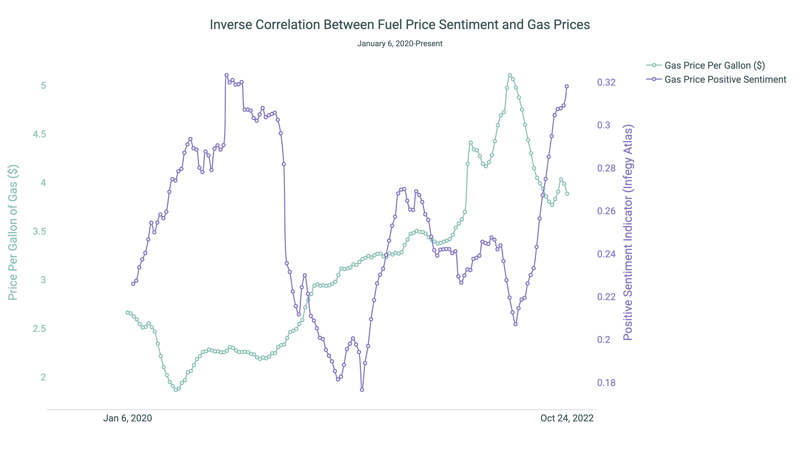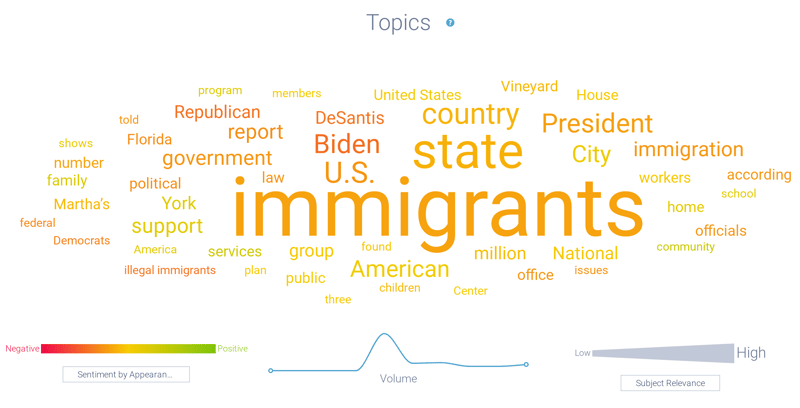Share this
Social Listening Insights on 2022 Midterm Elections
by Henry Chapman on November 1, 2022
Clustering narratives around Joe Biden and US Midterm Elections
Using Infegy Atlas’s new clustering algorithm, we can search hundreds of millions of posts online and cluster them by topic. This gives us a network of top topics that voters care about when it comes to 2022 midterm elections.
To create this, we queried “Joe Biden” to see the most important issues that voters were most vocal about. Infegy Atlas searched and categorized hundreds of thousands of documents in seconds.
In this brief, we go over the topics our study revealed – specifically, the business-relevant ones you’ll want to remain aware of here, at the end of the 2022 election season.

Using social listening data to analyze midterm elections
Figure 2 shows a US voter turnout correlation with social post volume. It shows that when people post about voting online, there is a higher likelihood of high voter turnout rates. This correlation holds true across both midterm and general elections and across both major political parties.
As 2022 is a midterm election, we expect voter turnout to be depressed, as is traditional with national midterm elections.

Interest rates, gas prices, and inflation
The large blue cluster in Figure 3 represents the thousands of posts discussing Joe Biden and inflation, gas prices, and the American economy as a whole.
This shows many US voters are concerned with the increased inflationary economic environment and the higher gas prices that come along with that. Emerging from a global pandemic and economic shutdown, American dollars are not going as far as they once were.

Correlation between Federal Funds Rate and post volume
Figure 4 shows a correlation between the Federal Reserve’s Federal Funds rate adjustment and Infegy Post Volume around “interest rates.” Interest rates steadily climbed through March 2020. When the pandemic hit, the Fed slashed rates. Correspondingly, we see a big spike in post volume as the Fed cut rates.
This is highly relevant for the 2022 midterms. As the Federal Reserve rapidly hikes interest rates, consumers find borrowing money to be increasingly expensive. This makes it harder to buy a house, a car, or pay off a credit card. Joe Biden and the Democrats will have to fight Federal Reserve-induced headwinds in order to keep the House and Senate.

Correlation between per gallon price of gas and post volume
Figure 5 shows a correlation between post volume of people talking about gas prices and the actual price per gallon of gasoline in the US. You can see that when gas prices spiked in March 2022, social post volume also spiked.
Social data tends to reveal reactions to social and economic events. This creates large spikes. While post volume dropped after the initial change, gas prices continued to climb. Social media users' attention began to correspondingly increase.

Inverse correlation between sentiment and fuel prices
Predictably, sentiment around gas prices is inversely correlated with the gas prices themselves. Figure 6 shows as COVID-19 cratered gas prices, consumers’ sentiment online spiked. On the flip side, as gas prices spiked post pandemic, consumers’ sentiment around gas prices cratered.
People don’t like paying extra to fill up their car. That displeasure has been closely tied with the Democrats’ future control of Congress.

Inflation Reduction Act
Joe Biden’s administration fought hard to pass their signature Inflation Reduction Act, a multi-billion dollar spending package that seeks to improve American infrastructure. The Biden administration spent much of its political capital trying to persuade West Virginia Senator Joe Manchin to back the bill. Infegy data confirms this connection, showing that users frequently post about Joe Manchin when talking about the Inflation Reduction Act.

Figure 7: The second largest cluster that Infegy's narratives detected was of documents related to the Inflation Reduction Act; Infegy Atlas data.
Dwindling Post Volume - Inflation Reduction Act
Despite that Democrat legislative effort, post volume data doesn’t appear to suggest that voters think much about the bill that was passed. From our data, voters appear to post more about immediately relevant topics like inflation or gas prices.
By comparison, post volume around the Inflation Reduction Act peaked at its passage, but has dwindled to a fraction of its original strength. This suggests that it’s not a factor that will motivate voters to go to the polls.

The word cloud in Figure 9 shows negative topics associated with Biden’s Inflation Reduction Act. Voters criticized the massive spending bill at a time of record high inflation in America. Additionally, Republicans criticized the expansion of IRS enforcement powers, believing this represented a government overreach.
Despite these negative attributes, the data shows that the Inflation Reduction Act’s significance has been supplanted by more immediate issues concerning voters such as inflation, interest rates, and high gas prices.

Migration and the border
Democrats have long faced weakness around US Border security, especially in southern states. President Joe Biden has not fared better than his predecessors.
Joe Biden’s topic cluster shows that immigration related issues make up a sizable chunk of conversation when people talk about Biden or the Democrats.

Post volume surges around midterm elections
Over the last several election seasons, immigration issues have predominantly come up in US midterm elections. GOP campaigns use them as a wedge issue to move voters to the polls. Traditionally, Democrats have been viewed as “softer” on immigration-related issues.
The 2018 midterms saw a huge focus on a migrant “caravan” that was supposedly moving from Honduras to the southern border. This dominated conversation in the 2018 midterms issues, but faded away after the election.

The 2022 midterms also has migration and immigration related issues coming to the forefront. GOP governors of southern states have taken to flying migrants and refugees to Democrat strongholds like Washington DC, New York City, and even Martha’s Vineyard.
Governor DeSantis of Florida and Governor Greg Abbott of Texas have used this strategy to garner overwhelmingly positive conservative support online for their actions. For example, Greg Abbott’s migration antics have garnered a 90% positive sentiment across his supporters. President Biden, on the other hand, only has a 23% positivity rate.


Unsurprisingly, Infegy Atlas shows that GOP-controlled border states like Texas, Arizona, and Florida have higher post volume related to immigration-related issues. This makes sense, as those governors stand more to gain by highlighting Democrat weakness.
States like California or New Mexico, despite being border states, have comparatively less post-volume around immigration-related issues.

Abortion restrictions motivate Democrats
Since the US Supreme Court has overturned Roe v. Wade, the Democratic Party has been using the abortion issue to attract donations and motivate voters to get out to vote.
However, Infegy Atlas shows the abortion-related documents cluster to be much smaller than the economic clusters around inflation, higher gas prices, and interest rate issues. Whether single-issue voters will turn around the midterm elections remains to be seen.

Democratic voters post more frequently about abortion
This Democrat strategy has has been successful once already, as evidenced by a high turnout Kansas referendum where voters protected a woman’s constitutional right to an abortion. This result surprised many politicos, as Kansas is traditional viewed as a conservative stronghold.
Infegy Atlas data shows that self-identified Democrats are more than twice as likely to post about abortion related issues as Republicans.

Inflation post-volume gains ground over abortion
Infegy Atlas post volume has shown that inflation conversation has grown over the past weeks as the Federal Reserve’s rate increases have not had their desired effect. As we get closer to the election, Republican candidates are likely to capitalize on this advantage by highlighting Democrat economic weaknesses. This could motivate their voters to the polls. This growing inflation-related post volume suggests that the mood of the electorate is shifting away from social issues and moving towards more economic issues.

Conclusion
In this brief, we looked at how social listening data can deliver insights into the momentum of national elections. Using our new topic clustering algorithm, we highlighted the four most impactful areas that are motivating voters to participate in this election.
Understanding how voters react to these issues will help campaigns direct advertising dollars to make sure their message reaches the right voter at the right time. These insights could be the difference between winning and losing an election.
Key Takeaways from Midterm Elections Social Listening
Explore the impact of voter concerns on the 2022 US Midterm Elections through social listening insights.
Voter Concerns on Economy & Inflation
High inflation and gas prices dominate voter discussions, impacting Joe Biden's economic strategies.
Interest Rates & Economic Headwinds
Federal Reserve rate hikes and their social media reactions indicate borrowing difficulties influencing voter sentiment.
Gas Prices & Social Sentiment
Spikes in gas prices lead to negative sentiment online, shaping voter concerns and Democratic prospects.
Inflation Reduction Act's Limited Impact
Despite initial buzz, focus dwindles as voters prioritize immediate economic issues over legislative achievements.
Migration, Border Issues & Political Strategy
Immigration concerns invigorate GOP campaigns, highlighting perceived Democrat weaknesses in border security.
Share this
- December 2025 (2)
- November 2025 (2)
- October 2025 (3)
- September 2025 (2)
- August 2025 (2)
- July 2025 (3)
- June 2025 (3)
- May 2025 (4)
- April 2025 (2)
- March 2025 (1)
- February 2025 (4)
- January 2025 (1)
- December 2024 (2)
- November 2024 (2)
- October 2024 (4)
- September 2024 (2)
- August 2024 (2)
- July 2024 (2)
- June 2024 (2)
- May 2024 (2)
- April 2024 (2)
- March 2024 (2)
- February 2024 (2)
- January 2024 (2)
- December 2023 (3)
- November 2023 (3)
- October 2023 (4)
- September 2023 (4)
- August 2023 (4)
- July 2023 (4)
- June 2023 (3)
- May 2023 (5)
- April 2023 (3)
- March 2023 (7)
- February 2023 (3)
- January 2023 (4)
- December 2022 (2)
- November 2022 (3)
- October 2022 (4)
- September 2022 (2)
- August 2022 (3)




.png?width=64&height=64&name=linkedin%20(1).png)